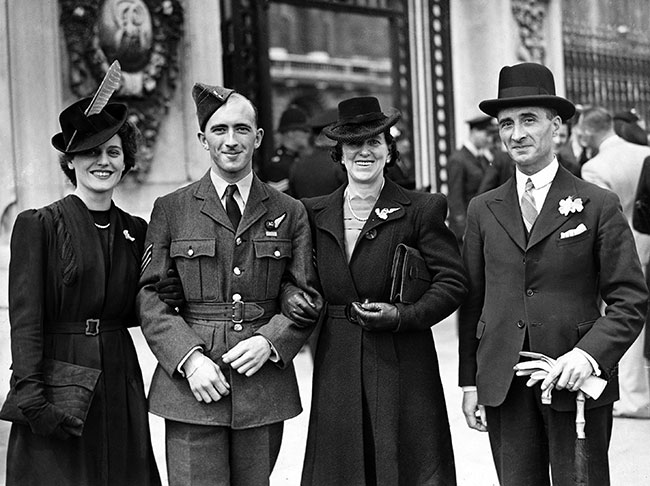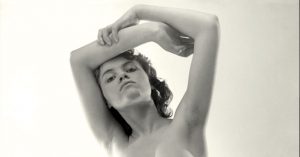Originally posted on Dambusters Blog.
The rest of the crew of AJ-O are also featured.
Pilot: Flt Sgt W C Townsend DFM
Flight engineer: Sgt D J D Powell
Navigator: Plt Off C L Howard
Bomb aimer: Sgt C E Franklin DFM
Wireless operator: Flt Sgt G A Chalmers
Rear Gunner: Raymond Wilkinson

Sgt D E Webb: Front gunner
Lancaster serial number: ED886/G
Call sign: AJ-O
Third wave. The only aircraft to attack Ennepe Dam. Mine dropped successfully but failed to breach the dam.
Douglas Edward Webb was born in Leytonstone, London on 12 September 1922, one of the two children of Edward and Daisy Webb. After leaving school, he worked briefly for Ilford and then for the London News Agency in Fleet Street, as a photographic printer. He joined the RAF in 1940, as soon as he had turned 18, as he wanted to be an air gunner.
After a substantial delay, he began training in 1942 and qualified as a gunner later that year. He was posted to 49 Squadron where he became one of Bill Townsend’s core crew, along with Dennis Powell, Lance Howard, and fellow gunner Ray Wilkinson. He flew on some 25 operations before the crew was transferred to the new 617 Squadron in March 1943.
As with all the front gunners on the Dams Raid, Webb was normally stationed in the mid-upper turret, but that had been removed in the modified Lancasters. He thought that he was going to be busy in this unaccustomed role, so he scrounged an extra 1000 rounds of ammunition for each gun from the squadron armoury.
The third wave was scheduled for take off more than two hours after the second, so Webb filled some of the time having a bath. He recalled later that he was convinced that he wasn’t going to come back, and that he wanted to “die clean”.
Fortunately, his premonition didn’t come true. From his seat in the front turret, he was able to see how dangerous the German defences were (he saw the shooting down of Burpee in “a bloody great ball of fire”), and also appreciate the airmanship of his skipper as Townsend flew as low as he dared. And his decision to bring extra ammunition proved vital since without it he would have run out during the trip.
Webb was awarded the DFM for his role on the raid. He didn’t believe this at first, suspecting he was being set up as part of some elaborate joke. Having checked, he then found a shop where he could buy the appropriate medal ribbons. Due to an administrative error, his actual medal was engraved “E Webb”, missing out his first name.
In July 1943, he flew with Bill Townsend on two of the raids on Italian targets and was then loaned to George Holden’s crew for another. In another stroke of fortune, he did not remain on the Holden crew, as in September they were all killed on the disastrous attack on the Dortmund Ems canal.
Webb was now tour expired, and he was posted to a conversion unit for a spell as an instructor, along with his rear gunner colleague Ray Wilkinson. The pair moved on to other training roles but in October 1944, they both came back on operations with 617 Squadron. He flew his first operation of this new tour in December, in Arthur Kell’s crew, and went on to fly on about another ten before the end of the war.
By the New Year Webb and Wilkinson were both in Ian Marshall’s crew. At this stage in the war, 617 Squadron was carrying out precision raids with 12,000lb Tallboy bombs. To save weight and because there was a reduced danger of German fighter attack, the mid-upper gunner was often not carried.
In March 1945 the even bigger 22,000lb Grand Slam came into service. By then the squadron had been supplied with 21 Lancasters, known as the B.I Special model, which had been built specifically for dropping these monster bombs. There is however some evidence that some aircrew carried on flying unofficially, perhaps to act as spotters.
It seems that Webb and Wilkinson therefore decided to take turns flying in the rear turret, and Webb recorded four operations in this position in March and April 1945 in his logbook. It is also likely that Webb was actually present on 617 Squadron’s last wartime operation, an attack on Hitler’s mountain lair on 25 April 1945. His colleague Ray Wilkinson and Len Sumpter, another Dams Raid participant, both flew on this sortie, making them the only two people to take part in 617 Squadron’s first and last wartime operations.
After demobilisation in 1946, Webb rejoined the London News Agency as a staff photographer. He went on to work in the film industry as a stills photographer and then opened his own studio in Soho, where he specialised in theatrical and film portraits. In 1948, he took some of the first professional nude pictures of the model and actress Pamela Green, thereby beginning an association that would last almost 50 years.
Webb had a prolific life in stills photography, cinema, and television. His television work included the title sequences for Special Branch and The Sweeney for Thames Television. In the latter, the famous enlarged fingerprints were those of Pamela Green.
Although they were never married, Webb and Pamela Green became life partners and in 1986 when Webb retired, they moved to the Isle of Wight together.
Douglas Webb died on 8 December 1996 in Yarmouth, on the Isle of Wight. Pamela Green stayed in the area, appearing in various TV documentaries and giving talks to the local WI, in which she was an active member. She died on 7 May 2010.
